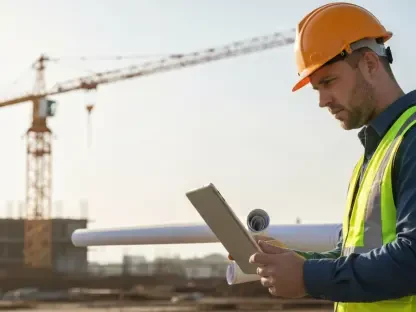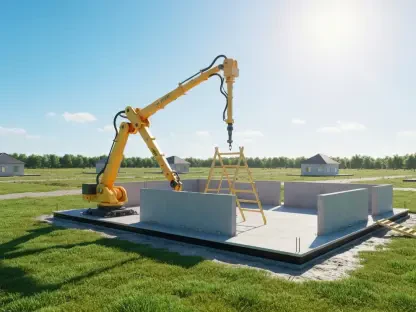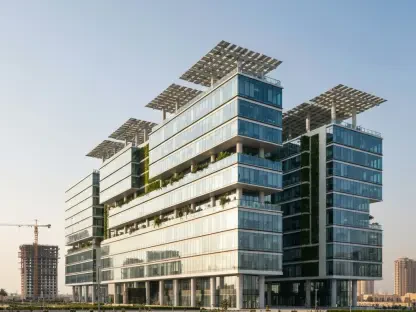The groundbreaking of the $2.3 billion Long Bridge project marks a transformative moment for rail travel along the East Coast. Officially launched with the presence of Transportation Secretary Pete Buttigieg and other notable officials, the project aims at alleviating one of the most significant rail traffic bottlenecks and improving both passenger and freight services across the corridor from Boston to Miami. This massive infrastructure undertaking is a critical component of Virginia’s Transforming Rail in Virginia initiative, focused on boosting rail capacity, efficiency, and reliability.
Significance and Objectives of the Long Bridge Project
Addressing Major Rail Bottlenecks
The Long Bridge project is primarily aimed at eliminating one of the East Coast’s worst rail bottlenecks, which currently slows down the entire rail network. With a 119-year-old bridge over the Potomac River, owned by CSX and used by both passenger and freight trains, acting as a significant choke point, the current system is overburdened. By constructing a new two-track railroad bridge adjacent to the existing one, the project will significantly ease congestion and eliminate delays caused by freight trains sharing the tracks with passenger services. This change will not only make rail travel faster but also more dependable for commuters and travelers alike.
The decision to create a separate bridge for passenger trains comes after extensive studies and feedback from various stakeholders, who all pointed to the inefficiencies caused by shared tracks. This updated solution aims to address long-standing complaints and operational challenges. With a dedicated bridge for passenger trains, there will be fewer disruptions, enabling smoother operation for freight trains on the old bridge. Furthermore, separating freight and passenger rail pathways aligns with global best practices, emphasizing the need for streamlined and efficient transportation systems tailored to specific needs.
Enhancing Passenger Rail Service
A critical objective of the new bridge is to facilitate smoother and more reliable passenger rail service, thus enhancing the travel experience for millions of passengers commuting along the East Coast corridor. As the new bridge will be exclusively for passenger trains, it provides a dedicated lane, making it possible for Amtrak and other passenger services to offer more punctual and faster transit times. This separation from freight traffic is expected to significantly enhance the travel experience for passengers, removing the delays and interruptions that have long plagued the current system.
Moreover, by relegating freight traffic to the old bridge and allowing passenger trains exclusive use of the new structure, there is a substantial capacity increase. This allocation means more trains can run on time, and schedules will be more predictable, attracting more people to opt for rail travel over other modes of transportation. Enhanced amenities and smoother operations are anticipated to make rail travel more competitive and appealing, particularly for long-distance travelers who prefer the convenience and comfort of trains over flights or long drives. The improvements are essential for both daily commuters and long-distance travelers, setting a new standard for passenger rail services in the region.
Impact on Virginia and Beyond
Boosting Statewide Infrastructure
The Long Bridge project is a key component of the broader Transforming Rail in Virginia initiative, designed to address the state’s severe traffic issues and improve its transportation network. By enhancing rail infrastructure, the project aims to provide a more efficient transportation alternative, potentially reducing road traffic congestion and contributing to environmental sustainability. DJ Stadtler, executive director of the Virginia Passenger Rail Authority (VPRA), emphasized that the project’s benefits will stretch well beyond Virginia, impacting all travelers along the corridor. The initiative represents a forward-thinking approach to addressing contemporary transportation challenges and improving the quality of life for residents.
The improvements expected from the project are not limited to easing congestion; they also aim to promote economic growth and boost regional connectivity. By offering higher-capacity and more reliable rail services, Virginia can anticipate increased business opportunities and tourism, bolstering the state’s economy. Additionally, the project is expected to support environmental objectives by offering a greener alternative to car and air travel, helping to lower the overall carbon footprint generated by transportation. The eco-friendly aspects of the project align perfectly with broader goals of fostering sustainable development and promoting more responsible use of resources.
Bipartisan Support and Broader Implications
The project enjoys robust bipartisan support, with elected officials from various political backgrounds recognizing the urgent need to update aging transportation infrastructure. This broad consensus underscores the project’s importance not just for Virginia but for the entire East Coast, setting a precedent for future large-scale infrastructure initiatives that require collective political will and cooperation. Such broad support highlights the shared understanding among policymakers of the critical role that modern, efficient rail systems play in maintaining a competitive edge and safeguarding economic vitality.
Furthermore, the collaboration between state and federal agencies, private corporations, and local communities exemplifies a model of effective public-private partnerships. These partnerships are increasingly seen as essential in addressing large-scale infrastructure needs that are beyond the capabilities of any single entity to handle alone. The joint efforts help distribute the project’s costs and risks while ensuring that the benefits are widespread and impactful. This cooperative approach paves the way for successful implementation and serves as a showcase for how similar future projects can be navigated.
Project Scale and Ancillary Developments
Construction of Additional Bridges
In addition to the main two-track bridge over the Potomac River, the Long Bridge project includes the construction of four smaller rail bridges. These ancillary structures are vital for ensuring seamless rail connections and improved logistic efficiencies across the regional network. The project also incorporates two bridges designated for pedestrians and cyclists, highlighting a commitment to multi-modal transportation solutions and community accessibility. This comprehensive approach aims to create a more connected and user-friendly transportation system, catering to different modes of travel and enhancing overall network integration.
The inclusion of pedestrian and cycling bridges is particularly noteworthy as it underscores the project’s broader vision of integrating various forms of transportation. By providing safe and convenient pathways for non-motorized commuters, the project promotes healthier lifestyles and alleviates road congestion. Moreover, these features foster greater community engagement and accessibility, transforming the surrounding areas into more inclusive and vibrant spaces. Such holistic planning ensures that the benefits of the project extend beyond just rail users to the broader community, creating shared public spaces that enhance quality of life.
Phased Contractor Selection
The project is divided into two main construction packages, reflecting its scale and complexity. A joint venture between Swedish builder Skanska and Flatiron, based in Broomfield, Colorado, has been selected for the Long Bridge-North portion. Meanwhile, the Franconia-Springfield Bypass will be managed by a collaboration between Flatiron and Herzog, a firm from St. Joseph, Missouri. The phased approach to contractor engagement underscores a meticulous planning strategy designed to manage the project’s diverse construction needs effectively. This division allows for focused execution on different segments of the project, ensuring that each phase meets the highest standards of quality and efficiency.
The selection process for contractors is crucial as it determines the project’s execution quality and adherence to timelines. By engaging experienced companies known for their expertise in large-scale infrastructure, the project aims to mitigate risks and ensure timely completion. Each contractor has been chosen for their specific strengths and capabilities, with overlapping responsibilities ensuring smooth transitions between different stages. This strategic planning helps to streamline operations and manage any potential issues that may arise, maintaining a consistent trajectory toward the project’s completion.
Timeline and Execution
Initial Site Preparations and Public Expectations
With the groundbreaking ceremony marking the project’s official start, initial site preparations are set to commence within a few weeks. These preliminary activities will prepare the site for full-scale construction, setting a solid foundation for the complex civil engineering tasks to follow. The public eagerly anticipates these developments, recognizing their potential to revolutionize rail travel on the East Coast. Early works will include land clearing, utility relocations, and the establishment of work sites, crucial steps that lay the groundwork for the extensive construction efforts planned.
As these activities get underway, stakeholders will closely monitor progress to ensure that the project adheres to environmental regulations and community guidelines. Public interest groups and local residents are particularly keen on understanding how initial developments will affect their daily lives and long-term community planning. Responsive and transparent communication from project managers will be key in maintaining public trust and support. This phase will also give engineers and contractors the chance to refine their plans and address any unexpected challenges that may arise before full-scale construction begins.
Long-Term Project Timeline
Full-scale construction is scheduled to begin in 2025, with an expected completion date in 2030, illustrating a well-organized, long-term planning strategy. This extended timeline allows for meticulous planning and phased execution, ensuring that every element of the project meets high standards of safety, efficiency, and durability. Such a thorough approach is essential, given the project’s ambitious scope and its critical role in enhancing regional connectivity. By adhering to a structured schedule, the project team can allocate resources effectively and address any potential delays or complications that may arise, reducing the overall risk.
The timeline also reflects the project’s multi-faceted nature, encompassing various construction phases and ancillary developments. Each stage will require detailed coordination between different teams and segments, from civil engineering to environmental management and public relations. By maintaining a clear timeline and establishing checkpoints for progress evaluation, the project ensures accountability and quality control at every step. This balanced approach aims to deliver a robust infrastructure upgrade that will serve the region for decades to come, advancing not just local but regional goals of connectivity and efficiency.
Broader Trends in Infrastructure Development
Specializing Transportation Routes
The Long Bridge project exemplifies a growing trend in infrastructure development: the creation of dedicated lanes or bridges for specific types of traffic. This approach aims to reduce congestion and improve overall network efficiency by providing specialized routes for different transportation modes. By dedicating the new bridge exclusively to passenger trains, the Long Bridge project aligns with this broader trend, promising smoother and more reliable travel. Such specialization also allows for improved safety and operational efficiencies, as infrastructure can be tailored more precisely to the needs and characteristics of different users.
This trend towards specialized routes reflects an evolving understanding of infrastructure as not merely functional but optimized for different types of traffic. It acknowledges the differing demands and behaviors of passenger versus freight transport, and the unique needs that arise from varying load capacities and trip frequencies. The Long Bridge project stands as a model for future developments, demonstrating how effective segregation of traffic types can lead to substantial improvements in service quality and overall network performance. It highlights the benefits of thoughtful planning in enhancing both user experience and operational reliability.
Modernizing Aging Assets
Another significant trend reflected in the Long Bridge project is the modernization of aging transportation infrastructure, which is essential for adapting to contemporary demands and technological advancements. Many of the United States’ key transit networks were built over a century ago and now require substantial updates to meet contemporary demands. By investing $2.3 billion to build the new bridge and associated infrastructure, the project aims to bring a critical segment of the East Coast rail network into the 21st century. Such modernization efforts are vital for maintaining competitive and efficient transport systems that support economic growth and environmental sustainability.
The focus on modernization goes beyond mere upgrades; it involves integrating advanced technologies and forward-thinking design principles to future-proof infrastructure. This project will incorporate state-of-the-art construction materials and methods, aiming for durability and resilience in the face of increasing demands and environmental challenges. Modernizing infrastructure also means improving accessibility and inclusivity, ensuring the facilities cater to diverse populations and provide equitable access. These updated systems will also be better equipped to handle emerging trends in mobility, from autonomous vehicles to enhanced digital connectivity, ensuring long-term relevance and efficiency.
Community Integration and Multi-Modal Solutions
Incorporating pedestrian and cyclist pathways within the Long Bridge project reflects a broader trend towards integrating multiple forms of transportation within a single infrastructure framework. This holistic approach aims to create more inclusive and accessible transit routes that cater to various users, from motorists to non-motorized commuters. By providing safe and convenient pathways for pedestrians and cyclists, the project promotes healthier and more sustainable travel options. This integration fosters vibrant, connected communities and reduces reliance on single-passenger vehicles, contributing to lower traffic congestion and emissions.
Community integration is a crucial aspect of modern infrastructure projects, as it ensures that the benefits extend beyond immediate users to the wider society. By embedding features that promote multi-modal transportation, the Long Bridge project serves as a catalyst for urban development and revitalization. It creates shared public spaces that encourage social interaction and economic activities, transforming surrounding areas into more livable and dynamic environments. These multi-modal solutions are key to fostering comprehensive urban mobility networks that are resilient, adaptable, and capable of meeting future demands.
Conclusion
The launch of the $2.3 billion Long Bridge project is a monumental development for rail travel along the East Coast. The groundbreaking ceremony was attended by Transportation Secretary Pete Buttigieg and other significant officials, highlighting the project’s importance. It aims to resolve one of the most problematic rail traffic bottlenecks and enhance both passenger and freight services from Boston to Miami. This ambitious infrastructure project is a vital part of Virginia’s Transforming Rail in Virginia initiative. The overarching goal of this initiative is to enhance rail capacity, improve efficiency, and increase reliability, making rail travel more dependable for thousands of commuters and freight operators. With improved infrastructure, the Long Bridge project is expected to significantly cut down delays and streamline operations along the entire corridor. This project is not only about immediate relief; it sets the stage for future expansions and ongoing improvements. The initiative underscores a commitment to modernizing the nation’s rail system, ensuring it meets the demands of contemporary travel and commerce. The project’s successful completion will be a major leap forward for rail transportation, impacting the economy and travel from the Northeast to the Southeast United States.









